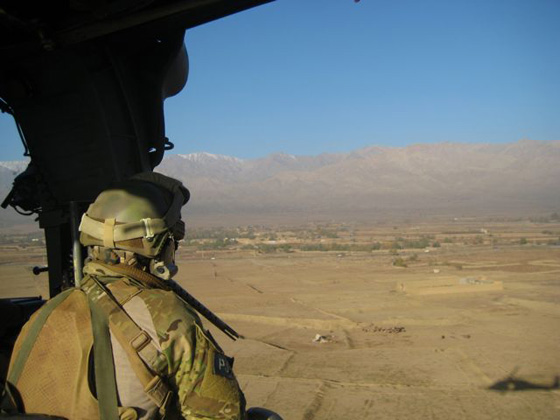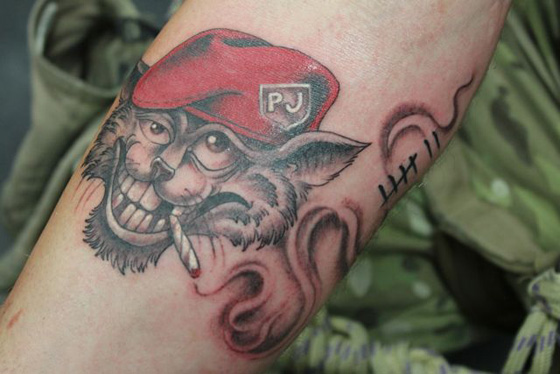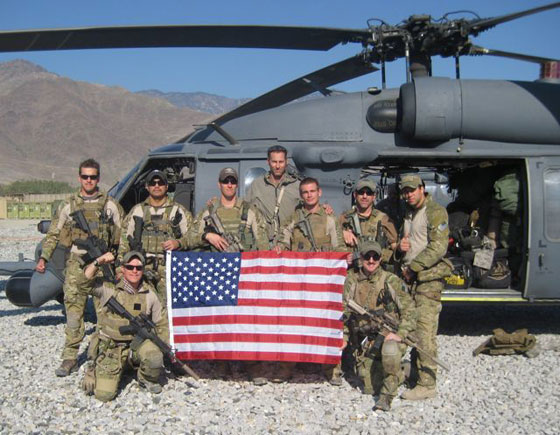http://www.huffingtonpost.com/david-r-kuhn/that-others-may-live_b_840127.html

But on this dark night in northern Afghanistan, it's their own lives that are endangered by the Taliban attackers on the ground just below. SrA Settle took shrapnel just above his left eye, below the helmet line, as their air unit arrived to rescue the compromised US troops. An inch another way, and he might not be here now.
Instead he's joking and smiling back at Bagram Air Field, and putting another line mark on his arm (his 7th), denoting the lives he's used up so far. "We think of ourselves as Alice in Wonderland, kind of like Cheshire Cat. Here, there, gone, invisible. We go in and get the bodies out, no matter what shape they're in, or how bad the hellfire's coming. We operate so 'that others may live', and that's our motto," Settle explains as he fingers his newly stitched wound. He'll be back with his unit immediately, ready for the next inevitable mission. The PJ's remain on 24-hour alert, 7 days a week, waiting for that next call to rescue. They're in the air within 15 minutes of any alert, and have wounded to a field hospital within an hour.
Settle recounts his story to a couple of talented NYC artists, without much thought about why they're sharing his barracks at this multi-national base for the war on terror in Afghanistan. These artists assimilate easily after the initial walls come down. Filmmaker Casey Neistat and fine-art maker Scott Campbell left New York City just a couple of days prior, and now bunk up with the men known as the "PJ's," or para-jumpers, to the constant sound of F-15s launching into the night. It's a natural fit for the rebellious artists, with the self-styled Special Forces unit, who themselves aren't afraid, or discouraged, from doing things their own way. Think "Battle Mustaches" (grown by most of the men while serving, but shaved off once home), and re-worked body bags, reinforced to lift more weight so twice as many men may be hoisted out, faster. Although neither are found in any military manual, the commanders accept both solutions as a way of dealing with war on this level. Neistat and Campbell have a habit of making their own rules, too.
Scott Campbell grew up in Louisiana, made his way west, and then started giving tattoos in the Haight section of San Francisco to a surly crowd. He had the talent, and there he gained the chops. Soon he moved to NYC, and set up a shop of his own in Williamsburg, Brooklyn. He kind of backed into being an artist, without some great plan. They say art finds you, not the other way around, and Campbell always felt tattoos were his thing. It was others that decided he had an artist's touch, and soon Heath Ledger, Sting and Courtney Love were calling. Campbell shows his fine art in galleries today, but it's giving tattoos that remain his core essence. "I get to work on living beings, interacting with them, and sharing in their stories. We create something together, and then it walks out the door. In that way there's nothing permanent about tattoos, and they can't be sold on to a new owner. You have to really want it, and as a result, they always have deep personal significance."
When Casey Neistat was commissioned to make a film about an artist, he chose Campbell. "Scott's a unique artist, and he's particularly talented with body art," Neistat offers, as he explains how this project came about. "To make the film I wanted to make, I had to get Scott to a place where his art means something deeper, not just the back streets of New York, but somewhere that's on its emotional edge." And as the director of this documentary short, Neistat wanted the product itself to be a work of art, too. "Why not make art about making art?" said the creator of the renowned Neistat Brothers television series airing on HBO earlier this year, where he released his own brand of serial video art work for an appreciative, almost worshiping audience. "I thrive on story story story, and intentionally use low-fi gear to avoid tripping up the message," he explains. "Scott gets it, and goes for the same deep meaning in giving his tattoos. It's all about the story, the message, the meaning of the experience that brings value, not just the tools or the price on the tag." No wonder Neistat wanted to work with Campbell, and in a place like the active warzone of Afghanistan. They both easily meshed with the PJ's, and soon found themselves sharing personal stories and a lot of laughs; just what these troops needed to come off the emotional edge of recent events.

"RPG at 3 o'clock!!" warned Senior Airman Jimmy Settle into his COM mic, but it was too late. The rocket-propelled grenade hit its mark, this time an American HH-60G Pave Hawk helicopter carrying the men of the 212th Rescue Squadron, comprised of Alaskan Air National Guardsmen. Their mission is to rescue isolated personnel from enemy territory in all geographic and environmental conditions, hostile or friendly. That is to say, these men save lives.But on this dark night in northern Afghanistan, it's their own lives that are endangered by the Taliban attackers on the ground just below. SrA Settle took shrapnel just above his left eye, below the helmet line, as their air unit arrived to rescue the compromised US troops. An inch another way, and he might not be here now.
Instead he's joking and smiling back at Bagram Air Field, and putting another line mark on his arm (his 7th), denoting the lives he's used up so far. "We think of ourselves as Alice in Wonderland, kind of like Cheshire Cat. Here, there, gone, invisible. We go in and get the bodies out, no matter what shape they're in, or how bad the hellfire's coming. We operate so 'that others may live', and that's our motto," Settle explains as he fingers his newly stitched wound. He'll be back with his unit immediately, ready for the next inevitable mission. The PJ's remain on 24-hour alert, 7 days a week, waiting for that next call to rescue. They're in the air within 15 minutes of any alert, and have wounded to a field hospital within an hour.
Settle recounts his story to a couple of talented NYC artists, without much thought about why they're sharing his barracks at this multi-national base for the war on terror in Afghanistan. These artists assimilate easily after the initial walls come down. Filmmaker Casey Neistat and fine-art maker Scott Campbell left New York City just a couple of days prior, and now bunk up with the men known as the "PJ's," or para-jumpers, to the constant sound of F-15s launching into the night. It's a natural fit for the rebellious artists, with the self-styled Special Forces unit, who themselves aren't afraid, or discouraged, from doing things their own way. Think "Battle Mustaches" (grown by most of the men while serving, but shaved off once home), and re-worked body bags, reinforced to lift more weight so twice as many men may be hoisted out, faster. Although neither are found in any military manual, the commanders accept both solutions as a way of dealing with war on this level. Neistat and Campbell have a habit of making their own rules, too.
Scott Campbell grew up in Louisiana, made his way west, and then started giving tattoos in the Haight section of San Francisco to a surly crowd. He had the talent, and there he gained the chops. Soon he moved to NYC, and set up a shop of his own in Williamsburg, Brooklyn. He kind of backed into being an artist, without some great plan. They say art finds you, not the other way around, and Campbell always felt tattoos were his thing. It was others that decided he had an artist's touch, and soon Heath Ledger, Sting and Courtney Love were calling. Campbell shows his fine art in galleries today, but it's giving tattoos that remain his core essence. "I get to work on living beings, interacting with them, and sharing in their stories. We create something together, and then it walks out the door. In that way there's nothing permanent about tattoos, and they can't be sold on to a new owner. You have to really want it, and as a result, they always have deep personal significance."
When Casey Neistat was commissioned to make a film about an artist, he chose Campbell. "Scott's a unique artist, and he's particularly talented with body art," Neistat offers, as he explains how this project came about. "To make the film I wanted to make, I had to get Scott to a place where his art means something deeper, not just the back streets of New York, but somewhere that's on its emotional edge." And as the director of this documentary short, Neistat wanted the product itself to be a work of art, too. "Why not make art about making art?" said the creator of the renowned Neistat Brothers television series airing on HBO earlier this year, where he released his own brand of serial video art work for an appreciative, almost worshiping audience. "I thrive on story story story, and intentionally use low-fi gear to avoid tripping up the message," he explains. "Scott gets it, and goes for the same deep meaning in giving his tattoos. It's all about the story, the message, the meaning of the experience that brings value, not just the tools or the price on the tag." No wonder Neistat wanted to work with Campbell, and in a place like the active warzone of Afghanistan. They both easily meshed with the PJ's, and soon found themselves sharing personal stories and a lot of laughs; just what these troops needed to come off the emotional edge of recent events.


